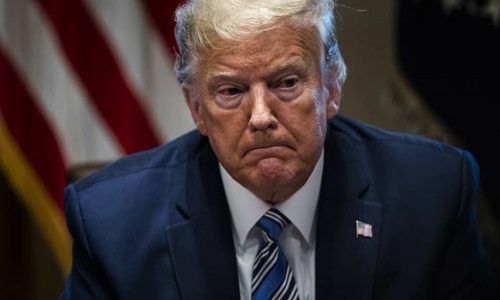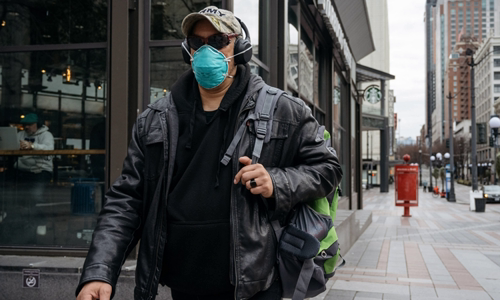Trump was expected to bring the United States out of chaos between Covid-19, but the decision from his Oval Office was further confusing.
President Donald Trump delivered an important speech on the evening of March 11 from the White House at a time when the whole country was in anxiety and fear before the Covid-19 pandemic.

President Donald Trump at the Oval Office, in the White House on March 11 Photo: Washington Post.
Trump's speech is very expected, in the context of the normal life rhythm of the Americans starting to stop when the school is closed, the NBA basketball tournament is delayed indefinitely, the hospital is on high alert. and actor and actor Tom Hanks confirmed to be infected with nCoV.
"nCoV has no chance of beating us. No country is more prepared and resilient than the United States," Trump opened the speech, before drawing a pink picture of the US economy, which is being seriously affected by Covid-19.
Trump announced a number of measures to support the economy to overcome difficulties and help workers who are isolated and greatly affected by the business closure, although his proposal to reduce income tax does not receive. have a lot of support in parliament.
But the most important announcement in Trump's statement, the ban on travel from 26 European countries to the US for 30 days to stop Covid-19, was immediately confusing.
On Twitter later, the US president hurriedly clarified that he issued a ban on passenger travel, not on transatlantic goods. White House officials also said the President's plan does not apply to Americans and permanent residents of the United States. However, this group of people still must comply with quarantine when returning to the US.
Trump continued to be misleading by claiming to persuade insurers to agree to co-pay for Covid-19 treatment. A White House official later explained Trump's statement meant free nCoV testing, but did not include medical expenses.
This confusion is a sign that a government often has problems in making specific policies and clearly introducing it. Trump's most important task in his March 11 speech was to show people that he was the leader of the country in difficult times. At the same time, Trump wants to confirm that he views the coming weeks as a very important time for the United States.
But misunderstandings about the travel ban have turned his speech into a controversial topic and may raise doubts about his leadership.
Apparently President Trump's travel ban should not be discussed with travel industry officials or US allies. Numerous ambassadors to European countries in Washington said they were not informed of the abrupt ban.
It also seems to be causing a major disruption, making the damage caused by the Covid-19 crisis even more severe. Trump's decision could cause a series of transatlantic flights to be canceled, pushing the aviation industry into a critical challenge period.
"This is not a financial crisis. It is only a temporary period that we will overcome together," Trump said in the speech. But his statement did not seem to help investors' panic after the Wall Street financial market plummeted. Dow Futures fell more than 1,000 points after the speech.
The new travel ban also raises doubts about Trump's understanding of the Covid-19 crisis, which he underestimated, blamed on Democrats and predicted it would soon disappear.

A masked man walks on a deserted street in Seattle, Washington Photo: NY Times.
Trump also did not explain why his ban did not include British citizens, where nCoV was also rooted.
But the biggest problem facing the US is not the number of new nCoV infections from Europe, but that the disease is spreading within the country itself. The urgent issues today are how Americans should respond to this situation and how much they need to change their daily activities. Trump recommends eliminating unnecessary visits to nursing homes, where the risk of nCoV is highest.
But he did not explain how to ease the health concerns about hospital overcrowding, the lack of appropriate testing equipment or the risk of exhausting a ventilator.
He said that the threat of Covid-19 to everyone is still "very low", except for the elderly and a history of illness. On the same day, one of his top health officials, Dr. Anthony Fauci, predicted that Covid-19 in the US would continue to deteriorate after causing more than 1,200 people infected and 38 people dead.
For Trump supporters, his speech was seen as decisive and bold action to confront the national challenge. But for others, this is just Trump's familiar act: blaming others for the crisis, praising himself and other antagonism, leaving people without a proper view of the actual situation. .
"This is the most active and comprehensive effort to deal with Covid-19 in modern history," Trump said.
But the US president did not mention the lack of testing equipment, which made it impossible for health officials to know the extent of Covid-19 in the United States. Until March 8, the US conducted tests for 1,700 people, too small compared to 50,000 in Italy and 23,000 in the UK.
US presidents often give speeches in the Oval Office in difficult situations to call for American solidarity and confront a common security threat.
But Trump's speech in an almost frustrating tone, when faced with external challenges could threaten his re-election efforts, is not the same as fulfilling the President's noble mission.
Trump's European travel ban created the impression that the nCoV was a "threat posed by outside forces to attack Americans", according to CNN commentator Stephen Collinson. However, Collinson said that this is a "myth" idea, because nCoV is a virus of natural origin and is affecting the whole of humanity.
As Covid-19 increasingly affected the United States, President Trump announced a series of measures to support businesses and individuals such as tax breaks and low-interest loans. But his plan to isolate himself from Europe is like "losing a new cow to build a stable", because Covid-19 is quietly infiltrating the United States, Collinson said.



 CarolynGillish
CarolynGillish







